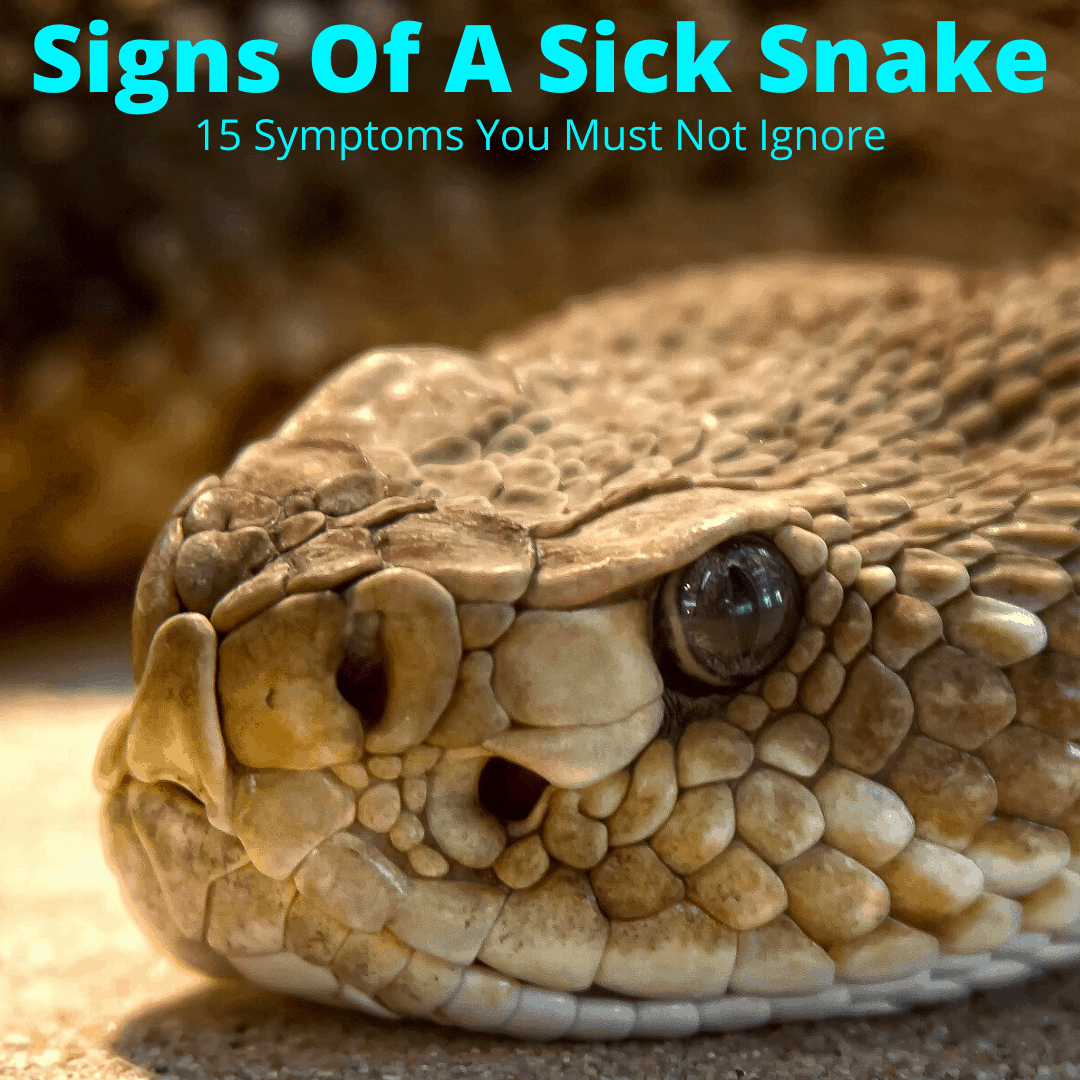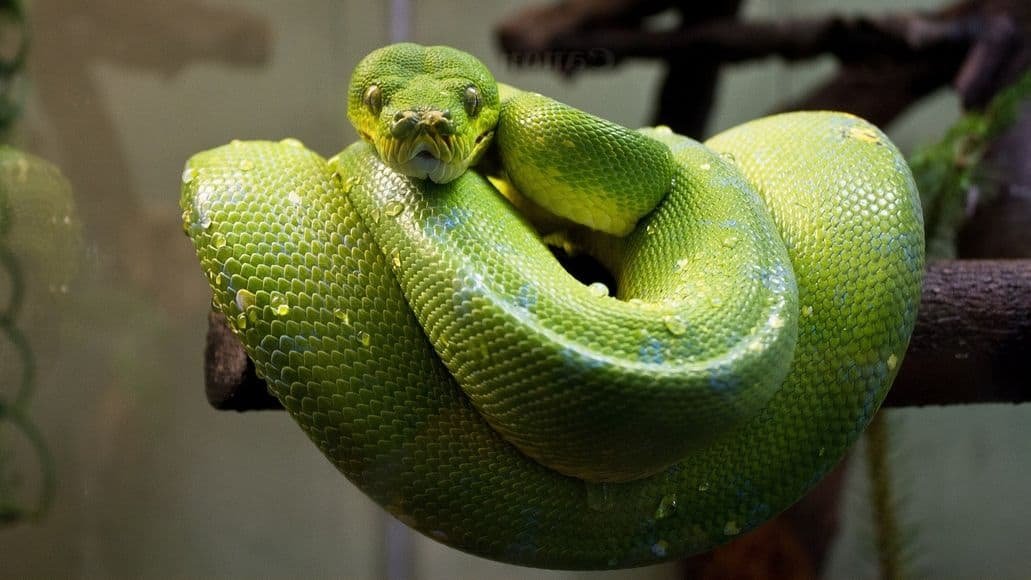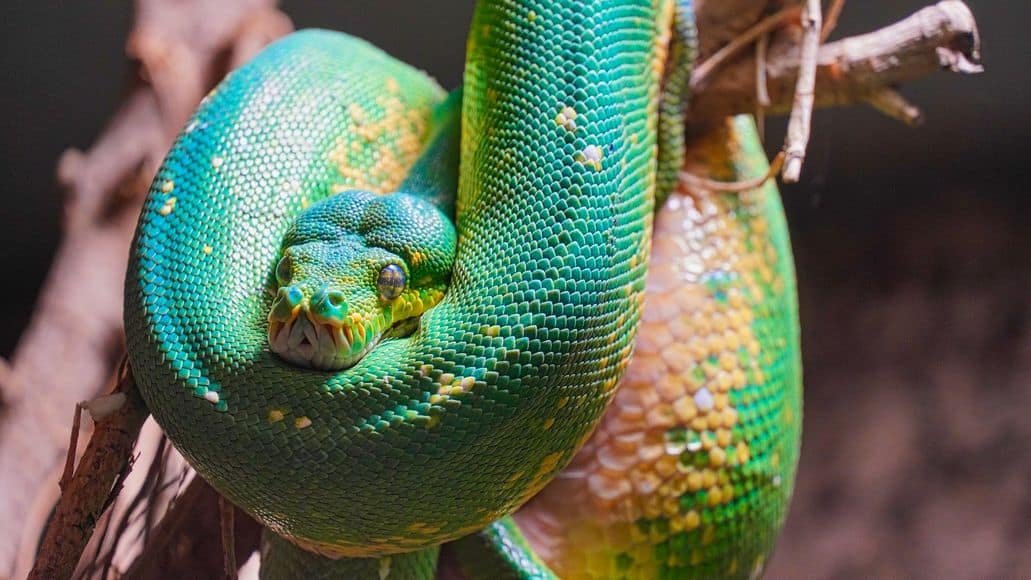
With some pets, it is easy to tell when they are sick. You can catch it in time and get them healthy again.
With snakes, it is not always easy to tell. You might not even notice your snake is sick until it is too late.
The signs of a sick snake are a bit more subtle than signs of sickness in some more common pets.
But that doesn’t mean you can’t tell at all when your snake is sick.
If you know what symptoms to look for, you will notice when your pet snake becomes ill early enough that you can get it the help it needs.
Let’s take a look at 15 common symptoms to look out for and follow that with some of the most common snake diseases.
Table of Contents
- 1 15 Signs Of Sickness In Pet Snakes
- 1.1 1. Lethargy
- 1.2 2. Prolonged Hiding
- 1.3 3. Loss Of Appetite
- 1.4 4. Dehydration
- 1.5 5. Weight Loss
- 1.6 6. Pinkish Or Reddish Skin
- 1.7 7. Stops Sticking Out Tongue
- 1.8 8. Limpness
- 1.9 9. Mucus Bubbles
- 1.10 10. Improper Shedding
- 1.11 11. Stringy Saliva
- 1.12 12. Hazy Or Opaque Eyes
- 1.13 13. Red And Black Specks
- 1.14 14. Swollen Gums
- 1.15 15. Egg Binding
- 2 Common Pet Snake Diseases
- 3 General Snake Health Tips
15 Signs Of Sickness In Pet Snakes

1. Lethargy
Your snake may be lethargic and less active than before. This could be a sign of disease or of it not getting enough heat.
2. Prolonged Hiding
A sick snake may hide or bury itself. While many snake species are quite shy and hiding is usual for them, if you notice that your pet’s behavior changes and that it is hiding for prolonged periods of time, this could be a sign of a sick snake.
3. Loss Of Appetite
Your pet may stop eating or show no interest in food, regardless of how or what it is fed. Some snakes may eat less at different times of the year (for instance in winter) but if they continue to show no appetite and no interest in the food you give them, there is cause for worry. This is especially true if they won’t even take notice of their favorite food.
4. Dehydration
Your pet snake may appear dehydrated. Signs of dehydration are sunken eyes or not shedding completely, but retaining pieces of unshed skin. Their saliva may also appear thick and sticky.
5. Weight Loss
Weight loss is another sign of illness. The weight loss is usually visible on the upper body and the bony spines of the vertebrae may start to appear more prominent. This sign of a sick snake can be even more obvious when you handle the animal.
6. Pinkish Or Reddish Skin
Look out for a pink or reddish hue to the skin along the underside of the snake’s body, as this could be an indication of sepsis, a very serious bacterial infection of the bloodstream. If you spot this, you need to get your snake to the vet immediately — no time to waste.
7. Stops Sticking Out Tongue
Your pet snake may also be too weak from illness to stick its tongue out to sample its environment.
8. Limpness
An ill or weak snake will simply lie limp when it would usually move away, or coiling up when it wants to move away from you.
9. Mucus Bubbles
A snake with bacterial or viral pneumonia will often have a symptom where bubbles of thick mucus are blown from the mouth or nose. If this is the case, see a vet must immediately.
10. Improper Shedding
Skin shedding issues, called dysecdysis, are quite common and also easy to spot. The most common shedding symptom is that not all the skin is shed, but that patches of dry and peeling skin remain on the snake.
11. Stringy Saliva
The snake may seem to have stringy saliva. This could mean that the snake is dehydrated, but could also be an early indication of thickened mucus caused by infection.
12. Hazy Or Opaque Eyes
One or both of the snake’s eyes may look hazy or have an opaque color to the surface. This happens when the clear scale that covers and protects the eye does not shed, but remains attached to the eye.
These “spectacles”, as they are sometimes called, can become infected by bacteria and may need medicated eye drops. It is a good idea to see the vet before any infection can occur and not to wait too long before you visit the vet. However, the most important thing is to NOT peel the scales off yourself as you could severely damage the corneas of the snake’s eyes.
13. Red And Black Specks
Small red and black specks around the snake’s mouth, lower jaw and eyes may be an indication of a mite infection. Other signs of a snake mite infection are a reduced appetite and irritability due to the discomfort.
The snake may also become anemic due to the blood taken from its body by the mites. The mites can be treated with an anti-parasitic medication your vet will be able to give you.
However, the whole snake enclosure must be thoroughly cleaned and disinfected as well. All porous items, like wood, should also be removed. This type of infection is one reason why good sanitation for your pet snake is so incredibly important. See below in the section “Common Pet Snake Diseases” for more information about parasites.
14. Swollen Gums
A snake with swollen gums and a bumpy and swollen jaw may have a mouth infection (also see “infectious stomatitis” further down in the post). It is necessary to take the snake to the vet for treatment if you notice this sign of a sick snake.
15. Egg Binding
Female snakes may get egg-binding, where they are not able to pass a formed egg. Egg-binding is also referred to as dystocia, egg retention, and post-ovulatory stasis.
Signs and symptoms of egg-binding are a lack of appetite and swelling in the lower half or third of their bodies. They may also be lethargic and hide. Take her to the vet as soon as possible as surgery may be necessary in some cases to remove the stuck egg(s).
The prognosis for animals with egg-binding, however, is good. Most animals recover completely and will still be able to reproduce. Egg-binding can be caused by various factors, including an anatomical defect in the female snake, an overly large or malformed egg.
Lack of a proper nesting site, improper temperatures or improper temperature cycling and humidity, stress, and even malnutrition can also be at fault. Egg-binding may happen more than once to a snake, so you always need to keep an eye on a female’s nesting and egg-laying.
Common Pet Snake Diseases
The following are diseases that commonly affect pet snakes. Be on the lookout for symptoms that indicate these diseases, so that you can take timely action and prevent serious harm to your snake.

Infectious Stomatitis
Also called Mouth Rot, the stomatitis usually present as pinpoint hemorrhages on the snake’s gums. The mouth may also be coated in a thick mucus which, in more severe cases, may contain blood or cottage cheese-like pus.
The snake may also breathe open-mouthed instead of through its nose. This is one of the times you definitely need to take your snake to a vet.
Mouth rot is usually not a primary issue, but a secondary one that results from a mouth injury, poor nutrition, improper environmental temperatures and even overcrowding. You’ll have to figure out what the primary cause of the stomatitis is and not just focus on healing the mouth, otherwise the infection will likely keep recurring.
Mouth rot is usually treated with injectable antibiotics and rinsing the mouth with antibiotic solutions.
Parasites
Your pet snake can suffer from both internal and external parasites. Internal parasites include various worms and coccidia, while external parasites are mites and ticks.
Although they often do not cause any (noticeable) symptoms in your pet snake, they are detected during the annual physical exam and fecal tests, which is just another reason you should take your snake in for an annual check-up.
Though they don’t always cause noticeable symptoms, these parasites may cause any of the following:
- Diarrhea
- Breathing difficulties — watch out, for instance, for mouth-breathing
- Regurgitation of food
- Swelling of the internal organs
- Itching
- Irritation
- Skin infections
- Anemia because of the amount of blood lost through the mite bites, etc.
- Mouth rot (see the paragraph on infectious stomatitis above)
- Weight loss, usually noticeable on the top of the snake’s body as the vertebrae become more prominent.
Parasites may be treated with an oral or injectable drug, after tests like a physical exam and fecal examination have identified which parasites are present.
Blister Disease (Scale Rot)
Usually caused by environments which are too moist or dirty (or both), the lesions are mostly on the underside (ventral) of the snake and may be easy to miss.
The blisters may become infected by aggressive bacteria and that is what causes the most harm, if not treated immediately.
This bacteria may cause not only skin and tissue damage, but even septicemia or blood poisoning and death (see also “septicemia” below). It is therefore imperative that you examine your pet snake regularly to catch any of these problems.
In some cases of blister disease, antibiotics may be required, although the disease can usually be managed by providing the proper environment and hygiene. Learn how to treat and prevent scale rot.
Inclusion Body Disease
Also referred to as IBD, this is a serious viral disease that pythons and boas may develop. It is usually associated with the nervous system, although it can also affect the respiratory (breathing) system or digestive tract.
Should a snake be affected, they will not be able to right themselves if placed on their backs, may “star gaze” and may even be paralyzed. Read “Can Snakes Have Seizures?” for more on stargazing and other types of spasms.
As you can imagine, you need to take your pet snake to the vet as soon as possible when you notice these symptoms in your boa or python. Unfortunately, there is no cure for IBD and the snake may have to be euthanized.
Respiratory Disease
Most respiratory infections in snakes are caused by bacteria and they are often seen together with mouth rot. However, viruses, fungii, and parasites may also cause respiratory problems and it is important that you see your vet make sure that your snake gets the appropriate treatment.
Symptoms of these respiratory infections include excess mucus in the mouth, nasal discharge, lethargy and loss of appetite. The snake may also breathe open-mouthed, make gurgling sounds or may even wheeze.
Treatments for respiratory diseases include antibiotics and, depending on the state the snake is in, even fluid therapy and force-feeding in the veterinary hospital. X-rays, blood tests and cultures are required to properly identify the cause of the infection.
Septicemia
Also called toxemia. This is a very serious condition and you need to get your snake to the vet immediately if you suspect septicemia.
Septicemia happens when bacteria or their toxins enter the bloodstream and other organs. When a snake has septicemia, it is often near death. They exhibit:
- Lethargy
- Lack of appetite
- Open-mouthed breathing
- A red discoloration to the scales of the underside of their body.
General Snake Health Tips
- Have your snake examined when you first get it.
- Don’t take snakes as pets from the wild and only buy from reputable breeders.
- Let your snake have an annual check-up — preventative medicine is always the best option!
- Any deviation from their normal behavior can be a sign for concern.
- Take your pet snake to the vet for an examination when you suspect it is ill. This is better than waiting too long for more symptoms to show up.
- Always keep your snake enclosure clean and hygienic to ensure that bacteria don’t build up inside and cause illness.
- Research the best way to keep your snake: learn all about humidity, water, food, size of the enclosure, etc.
Sources
- Common diseases of pet snakes By Rick Axelson, DVM
- How Can I Tell If My Snake Is Sick? By Laurie Hess, DVM
- Egg Binding (Dystocia) in Reptiles: Causes, Signs, Diagnosis, Treatment, and Prevention by Pet Coach
If this article has put you off getting a snake, make sure you read Pet Snakes – 7 Things to Consider when Choosing a Pet Snake before making a final decision.
Leave a Reply